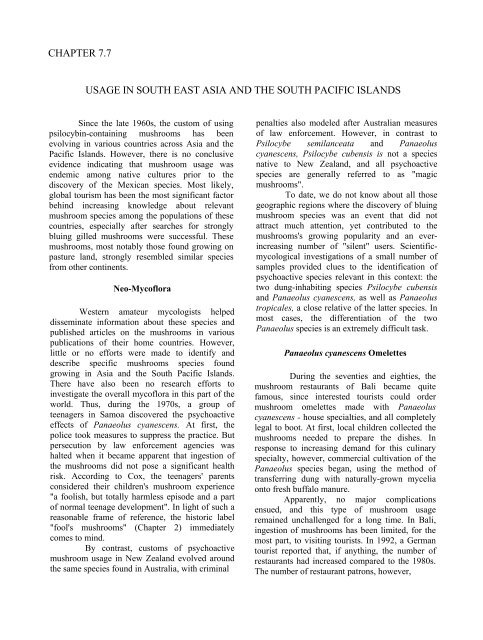Jochen Gartz - Magic Mushrooms Around the ... - preterhuman.net
Jochen Gartz - Magic Mushrooms Around the ... - preterhuman.net
Jochen Gartz - Magic Mushrooms Around the ... - preterhuman.net
You also want an ePaper? Increase the reach of your titles
YUMPU automatically turns print PDFs into web optimized ePapers that Google loves.
CHAPTER 7.7<br />
USAGE IN SOUTH EAST ASIA AND THE SOUTH PACIFIC ISLANDS<br />
Since <strong>the</strong> late 1960s, <strong>the</strong> custom of using<br />
psilocybin-containing mushrooms has been<br />
evolving in various countries across Asia and <strong>the</strong><br />
Pacific Islands. However, <strong>the</strong>re is no conclusive<br />
evidence indicating that mushroom usage was<br />
endemic among native cultures prior to <strong>the</strong><br />
discovery of <strong>the</strong> Mexican species. Most likely,<br />
global tourism has been <strong>the</strong> most significant factor<br />
behind increasing knowledge about relevant<br />
mushroom species among <strong>the</strong> populations of <strong>the</strong>se<br />
countries, especially after searches for strongly<br />
bluing gilled mushrooms were successful. These<br />
mushrooms, most notably those found growing on<br />
pasture land, strongly resembled similar species<br />
from o<strong>the</strong>r continents.<br />
Neo-Mycoflora<br />
Western amateur mycologists helped<br />
disseminate information about <strong>the</strong>se species and<br />
published articles on <strong>the</strong> mushrooms in various<br />
publications of <strong>the</strong>ir home countries. However,<br />
little or no efforts were made to identify and<br />
describe specific mushrooms species found<br />
growing in Asia and <strong>the</strong> South Pacific Islands.<br />
There have also been no research efforts to<br />
investigate <strong>the</strong> overall mycoflora in this part of <strong>the</strong><br />
world. Thus, during <strong>the</strong> 1970s, a group of<br />
teenagers in Samoa discovered <strong>the</strong> psychoactive<br />
effects of Panaeolus cyanescens. At first, <strong>the</strong><br />
police took measures to suppress <strong>the</strong> practice. But<br />
persecution by law enforcement agencies was<br />
halted when it became apparent that ingestion of<br />
<strong>the</strong> mushrooms did not pose a significant health<br />
risk. According to Cox, <strong>the</strong> teenagers' parents<br />
considered <strong>the</strong>ir children's mushroom experience<br />
"a foolish, but totally harmless episode and a part<br />
of normal teenage development". In light of such a<br />
reasonable frame of reference, <strong>the</strong> historic label<br />
"fool's mushrooms" (Chapter 2) immediately<br />
comes to mind.<br />
By contrast, customs of psychoactive<br />
mushroom usage in New Zealand evolved around<br />
<strong>the</strong> same species found in Australia, with criminal<br />
penalties also modeled after Australian measures<br />
of law enforcement. However, in contrast to<br />
Psilocybe semilanceata and Panaeolus<br />
cyanescens, Psilocybe cubensis is not a species<br />
native to New Zealand, and all psychoactive<br />
species are generally referred to as "magic<br />
mushrooms".<br />
To date, we do not know about all those<br />
geographic regions where <strong>the</strong> discovery of bluing<br />
mushroom species was an event that did not<br />
attract much attention, yet contributed to <strong>the</strong><br />
mushrooms's growing popularity and an everincreasing<br />
number of "silent" users. Scientificmycological<br />
investigations of a small number of<br />
samples provided clues to <strong>the</strong> identification of<br />
psychoactive species relevant in this context: <strong>the</strong><br />
two dung-inhabiting species Psilocybe cubensis<br />
and Panaeolus cyanescens, as well as Panaeolus<br />
tropicales, a close relative of <strong>the</strong> latter species. In<br />
most cases, <strong>the</strong> differentiation of <strong>the</strong> two<br />
Panaeolus species is an extremely difficult task.<br />
Panaeolus cyanescens Omelettes<br />
During <strong>the</strong> seventies and eighties, <strong>the</strong><br />
mushroom restaurants of Bali became quite<br />
famous, since interested tourists could order<br />
mushroom omelettes made with Panaeolus<br />
cyanescens - house specialties, and all completely<br />
legal to boot. At first, local children collected <strong>the</strong><br />
mushrooms needed to prepare <strong>the</strong> dishes. In<br />
response to increasing demand for this culinary<br />
specialty, however, commercial cultivation of <strong>the</strong><br />
Panaeolus species began, using <strong>the</strong> method of<br />
transferring dung with naturally-grown mycelia<br />
onto fresh buffalo manure.<br />
Apparently, no major complications<br />
ensued, and this type of mushroom usage<br />
remained unchallenged for a long time. In Bali,<br />
ingestion of mushrooms has been limited, for <strong>the</strong><br />
most part, to visiting tourists. In 1992, a German<br />
tourist reported that, if anything, <strong>the</strong> number of<br />
restaurants had increased compared to <strong>the</strong> 1980s.<br />
The number of restaurant patrons, however,








![The Big Lie 9-11 and Government Complicity in Mass Murder [PDF]](https://img.yumpu.com/50957077/1/190x245/the-big-lie-9-11-and-government-complicity-in-mass-murder-pdf.jpg?quality=85)








